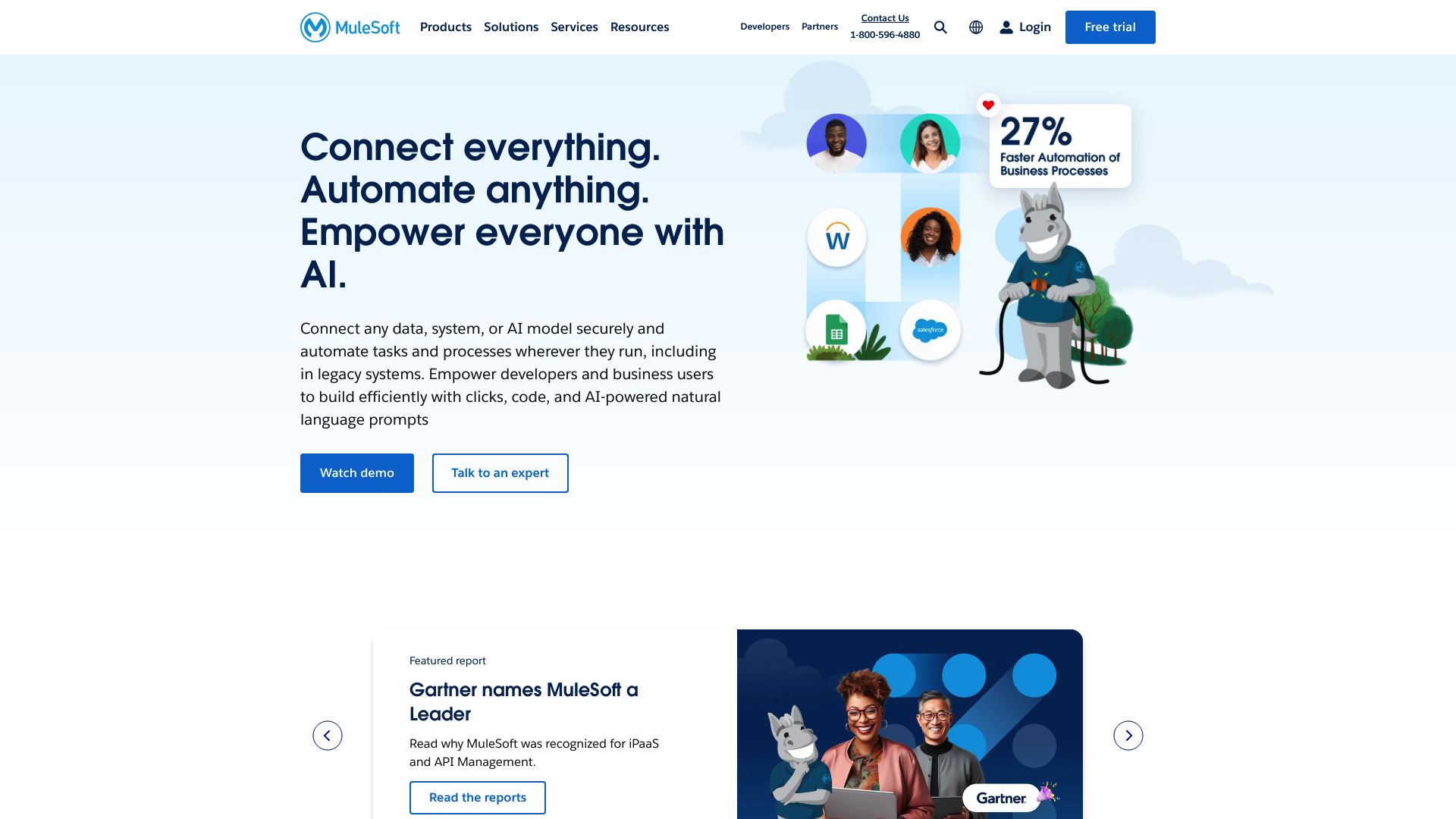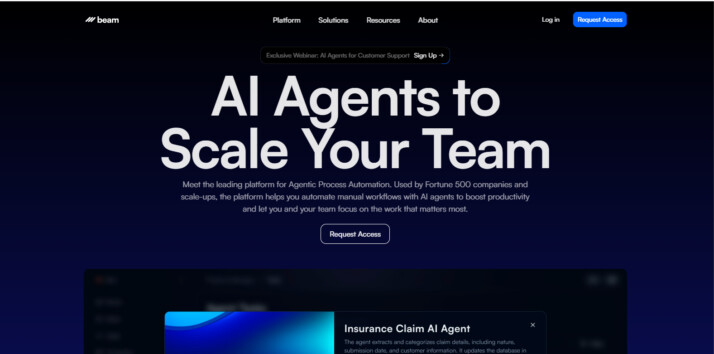Mulesoft vs. Beam AI: Comparing Enterprise Integration and AI Automation
AI platforms revolutionize business processes, but choosing the right solution can be daunting. This comparison delves into Mulesoft’s enterprise integration prowess, Beam AI’s task automation focus, and SmythOS’s innovative approach to AI development. We examine core features, security measures, and real-world applications to help you navigate the AI landscape.
Whether you’re a developer seeking robust API management, a business leader exploring AI-driven efficiency, or an entrepreneur looking for accessible AI tools, this analysis provides insights to guide your decision-making process. Discover how these platforms address diverse needs and learn why SmythOS stands out as a versatile, user-friendly solution for creating and deploying AI agents across various industries.
Mulesoft Overview
Mulesoft transforms enterprise connectivity with its powerful integration platform. The Anypoint Platform enables businesses to design, build, and manage APIs, connecting applications, data, and devices seamlessly. Mulesoft’s approach to API-led connectivity empowers organizations to create reusable assets, enhancing efficiency and flexibility in digital transformations.
Mulesoft transforms enterprise connectivity with its powerful integration platform. The Anypoint Platform enables businesses to design, build, and manage APIs, connecting applications, data, and devices seamlessly.


Mulesoft excels in providing robust solutions for enterprises seeking to streamline their integration processes. The platform’s strength lies in its comprehensive suite of tools, including Anypoint Studio for visual development, Flow Builder for no-code integrations, and Anypoint Flex Gateway for API management. These components work together to support a wide range of use cases, from simple data synchronization to complex, AI-driven workflows.
One of Mulesoft’s standout features is its integration with Einstein AI, which enhances developer productivity through natural language prompts for rapid project initiation. This AI-powered capability, combined with Mulesoft’s extensive library of pre-built connectors and templates, significantly reduces development time and complexity.
Mulesoft’s standout features is its integration with Einstein AI, which enhances developer productivity through natural language prompts for rapid project initiation.
While Mulesoft offers powerful integration capabilities, its learning curve can be steep for those new to API development. The platform’s enterprise focus may also make it less suitable for smaller organizations or individual developers with simpler integration needs. However, for large-scale enterprises dealing with complex, multi-system environments, Mulesoft’s robust security features, scalability, and comprehensive API lifecycle management tools make it a compelling choice.
Mulesoft’s position in the competitive landscape is strong, particularly in sectors requiring high levels of security and compliance, such as finance and healthcare. Its ability to provide both cloud-based and on-premises solutions gives it an edge in hybrid integration scenarios. As businesses continue to prioritize digital transformation and AI integration, Mulesoft’s ongoing innovation in these areas solidifies its role as a leader in the integration platform market.
Beam AI Overview
Beam AI delivers a powerful platform for creating and deploying AI agents to automate repetitive tasks across organizations. Their Agentic Process Automations (APAs) tackle data extraction, customer inquiries, compliance tasks, and order processing more efficiently than human workers. These AI agents continuously learn and adapt, improving their accuracy and speed over time.


Beam AI delivers a powerful platform for creating and deploying AI agents to automate repetitive tasks across organizations.
The platform excels in back-office automation, customer service, and regulatory compliance. Beam AI’s solutions integrate seamlessly with existing internal systems, allowing for comprehensive workflow automation. Their conversational interfaces enable smooth interactions between humans and AI agents, streamlining task management.
Beam AI emphasizes sustainability and speed in their approach. By minimizing steps and reducing human intervention, their automation solutions aim to save time and decrease carbon footprints. The company’s international team focuses on pushing the boundaries of artificial general intelligence (AGI), driving innovation in AI agent capabilities.
Beam AI emphasizes sustainability and speed in their approach. By minimizing steps and reducing human intervention, their automation solutions aim to save time and decrease carbon footprints.
While Beam AI offers robust features, potential users should consider integration complexity and scalability needs when evaluating the platform. The cost structure and customization options may also impact suitability for different organization sizes and industries. As with any AI solution, careful consideration of data privacy, security measures, and ethical implications is crucial before implementation.
Feature Comparison
Mulesoft and Beam AI offer distinct approaches to enterprise integration and AI automation. Mulesoft excels in robust API management and enterprise integration, while Beam AI focuses on creating AI agents for task automation.
In core components, Mulesoft’s Anypoint Platform provides comprehensive API lifecycle management, including design, implementation, and monitoring. Beam AI, however, emphasizes its Agentic Process Automations (APAs) for automating repetitive tasks. Mulesoft’s visual development environment, Anypoint Studio, contrasts with Beam AI’s focus on autonomous AI agents that learn and adapt over time.
Security features highlight another key difference. Mulesoft offers extensive security measures, including data encryption, OAuth support, and IP whitelisting. Beam AI’s documentation lacks specific details on security implementations, though they likely incorporate standard protections. Mulesoft’s enterprise focus results in more comprehensive and transparent security protocols compared to Beam AI’s AI-centric approach.
While both platforms aim to improve efficiency and automation, they cater to different needs within the enterprise technology ecosystem. Mulesoft’s strength lies in connecting diverse systems and managing complex API infrastructures, whereas Beam AI specializes in creating AI agents for specific task automations.
Feature Comparison Table
| Mulesoft | Beam AI | SmythOS | |
|---|---|---|---|
| CORE FEATURES | |||
| Visual Builder | ✅ | ❌ | ✅ |
| No-Code Options | ✅ | ❌ | ✅ |
| Memory & Context | ❌ | ✅ | ✅ |
| Explainability & Transparency | ❌ | ✅ | ✅ |
| Debug Tools | ✅ | ❌ | ✅ |
| Multimodal | ✅ | ❌ | ✅ |
| Problem-Solving Capabilities | ❌ | ✅ | ✅ |
| Human-AI Interaction | ❌ | ✅ | ✅ |
| Audit Logs for Analytics | ❌ | ✅ | ✅ |
| SECURITY | |||
| Data Encryption | ❌ | ✅ | ✅ |
| COMPONENTS | |||
| Huggingface AIs | ❌ | ✅ | ✅ |
| Zapier APIs | ❌ | ✅ | ✅ |
| All other APIs, RPA | ❌ | ✅ | ✅ |
| Logic | ❌ | ✅ | ✅ |
| Data Lakes | ✅ | ❌ | ✅ |
| DEPLOYMENT OPTIONS (EMBODIMENTS) | |||
| Deploy as Scheduled Agent | ❌ | ✅ | ✅ |
| Scalability | ❌ | ✅ | ✅ |
| DATA LAKE SUPPORT | |||
| Hosted Vector Database | ✅ | ❌ | ✅ |
| Sitemap Crawler | ❌ | ❌ | ✅ |
| YouTube Transcript Crawler | ❌ | ❌ | ✅ |
| URL Crawler | ❌ | ❌ | ✅ |
| PDF Support | ❌ | ✅ | ✅ |
Best Alternative to Mulesoft and Beam AI
SmythOS stands out as the superior alternative to Mulesoft and Beam AI, offering a comprehensive agentic AI automation platform that combines the best of both worlds. Our platform empowers users to create, deploy, and manage AI agents with unparalleled ease and flexibility.
Unlike Mulesoft’s complex API management focus or Beam AI’s narrow emphasis on task-specific automations, SmythOS provides a versatile solution for building intelligent agents capable of handling a wide range of use cases. Our drag-and-drop visual builder eliminates the need for extensive coding knowledge, making AI development accessible to both technical and non-technical users alike.
SmythOS provides a versatile solution for building intelligent agents capable of handling a wide range of use cases.
SmythOS excels in its extensive feature set, offering capabilities that outshine both Mulesoft and Beam AI. We provide robust memory and context management, ensuring AI agents maintain coherent conversations and retain important information. Our platform also supports multimodal interactions, allowing agents to process and respond to various data types, including text, images, and more. These advanced features enable the creation of sophisticated AI solutions that can adapt to complex business needs.
Scalability and deployment options set SmythOS apart from the competition. While Mulesoft struggles with scalability and Beam AI lacks transparency in this area, our platform is designed to grow with your business needs. We offer flexible deployment options, including APIs, webhooks, scheduled agents, and even integration with popular AI models like GPT. This versatility ensures that SmythOS can seamlessly integrate into existing workflows and systems, providing a future-proof solution for enterprises of all sizes.
By choosing SmythOS, users gain access to a powerful, all-in-one platform that combines the strengths of API management and AI agent creation while overcoming the limitations of both Mulesoft and Beam AI. Our commitment to user-friendly design, extensive integration capabilities, and cutting-edge AI technologies makes SmythOS the ideal choice for businesses looking to harness the full potential of AI automation.
Conclusion
Mulesoft and Beam AI offer powerful solutions for enterprise integration and AI automation, respectively. Mulesoft excels in API management and connecting diverse systems, while Beam AI focuses on creating adaptive AI agents for task automation. Both platforms address critical needs in the evolving digital landscape, but each has its strengths and limitations.
While Mulesoft provides robust integration capabilities and security features ideal for large enterprises, its steep learning curve may pose challenges for smaller organizations or those new to API development. Beam AI’s emphasis on AI-driven automation shows promise for increasing efficiency in repetitive tasks, but potential users should carefully consider factors like integration complexity and scalability.
SmythOS emerges as a superior alternative, combining the strengths of both platforms while addressing their limitations. Our platform offers a user-friendly drag-and-drop interface for creating complex AI workflows, extensive integration options, and versatile deployment capabilities. SmythOS empowers users to build and manage AI agents with unprecedented speed and efficiency, making advanced AI functionalities accessible to a broader audience.
We invite you to experience the power of SmythOS firsthand. Create a free SmythOS account today and join the AI revolution. With our risk-free trial and unlimited agent creation, you can explore how SmythOS can transform your business processes and drive innovation. Discover our extensive library of AI agent templates to jumpstart your journey into the future of AI-powered automation.
Last updated:
Disclaimer: The information presented in this article is for general informational purposes only and is provided as is. While we strive to keep the content up-to-date and accurate, we make no representations or warranties of any kind, express or implied, about the completeness, accuracy, reliability, suitability, or availability of the information contained in this article.
Any reliance you place on such information is strictly at your own risk. We reserve the right to make additions, deletions, or modifications to the contents of this article at any time without prior notice.
In no event will we be liable for any loss or damage including without limitation, indirect or consequential loss or damage, or any loss or damage whatsoever arising from loss of data, profits, or any other loss not specified herein arising out of, or in connection with, the use of this article.
Despite our best efforts, this article may contain oversights, errors, or omissions. If you notice any inaccuracies or have concerns about the content, please report them through our content feedback form. Your input helps us maintain the quality and reliability of our information.
